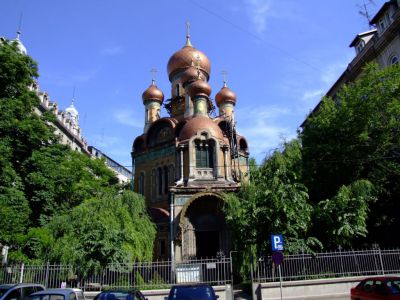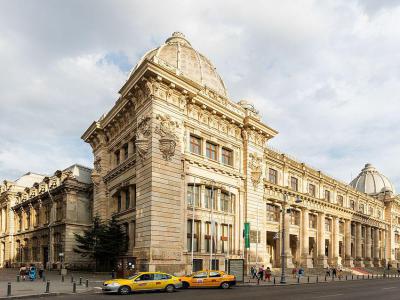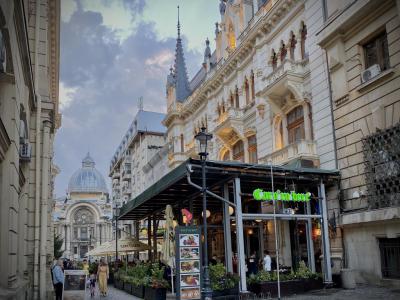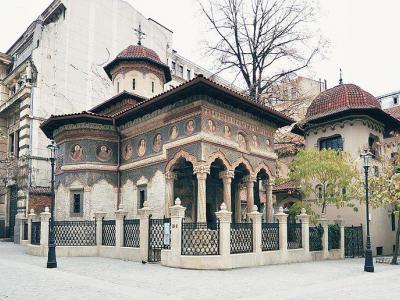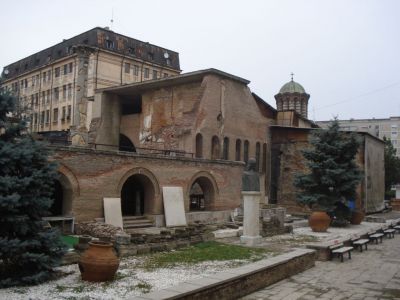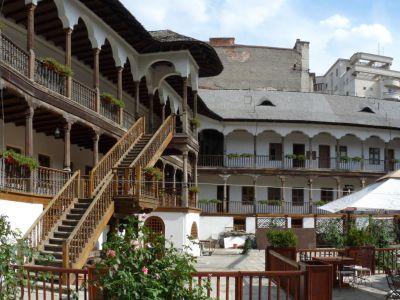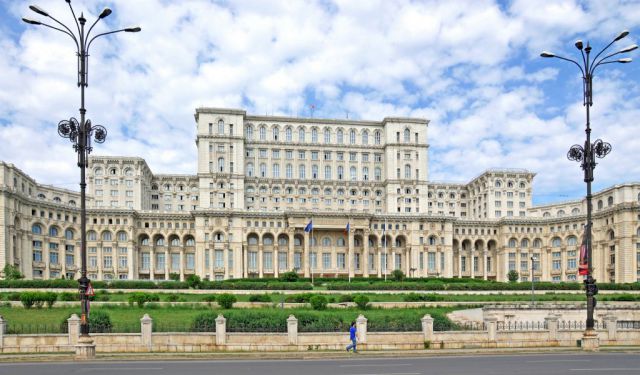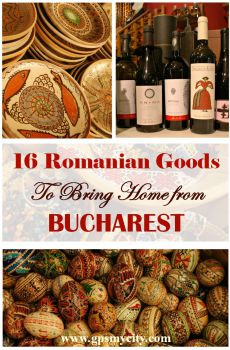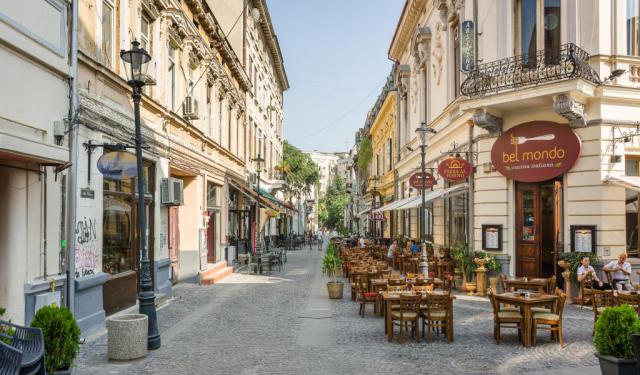
Old Town Walking Tour (Self Guided), Bucharest
The Historical Center of Bucharest, or the Old Town, as the locals habitually refer to it, is one of the most beloved and attractive areas in the Romanian capital. The neighborhood is really beautiful a place to visit, and you can walk into it pretty much from anywhere in central Bucharest. Ion Constantin Brătianu Boulevard crosses the historic heart of the city from Piata Universitate (University Square), in the north, to Piata Unirii (Union Square) in the south, splitting it into two almost equal parts.
Steeped in a mix of neoclassical and neo-baroque architecture, the grand Old Town area is an open-air museum, featuring excavated medieval ruins of Curtea Veche, the former court of infamous ruler Vlad the Impaler, and the National Museum of Romanian History showcasing religious icons and royal treasures in a former palace.
Not far from University Square stands the Russian Orthodox Church of St. Nicholas, commissioned in 1905. Further afield, tucked away between taller buildings is yet another, more ancient, 18th-century church of the Stavropoleos Convent.
Hanul cu Tei (The Linden Tree Inn), on Strada Lipscani (Lipscani street), is one of the few historic inns still existing in Bucharest. Having largely retained its original appearance since 1833, the Inn hosts one of the biggest art galleries in the country, featuring vintage furniture, tapestries, rugs, paintings, and other artifacts.
Another historical inn – Hanul lui Manuc (Manuc's Inn) – is the oldest operating hotel in the city. It also houses a popular restaurant, several bars, a coffee-house, stores, and an extensive bar.
If you care to wander through the cobbled lanes of Bucharest’s Old Town and explore its attractions in more detail, do it in your good time and at your own pace with the help of our self-guided walking tour and enjoy yourself!
Steeped in a mix of neoclassical and neo-baroque architecture, the grand Old Town area is an open-air museum, featuring excavated medieval ruins of Curtea Veche, the former court of infamous ruler Vlad the Impaler, and the National Museum of Romanian History showcasing religious icons and royal treasures in a former palace.
Not far from University Square stands the Russian Orthodox Church of St. Nicholas, commissioned in 1905. Further afield, tucked away between taller buildings is yet another, more ancient, 18th-century church of the Stavropoleos Convent.
Hanul cu Tei (The Linden Tree Inn), on Strada Lipscani (Lipscani street), is one of the few historic inns still existing in Bucharest. Having largely retained its original appearance since 1833, the Inn hosts one of the biggest art galleries in the country, featuring vintage furniture, tapestries, rugs, paintings, and other artifacts.
Another historical inn – Hanul lui Manuc (Manuc's Inn) – is the oldest operating hotel in the city. It also houses a popular restaurant, several bars, a coffee-house, stores, and an extensive bar.
If you care to wander through the cobbled lanes of Bucharest’s Old Town and explore its attractions in more detail, do it in your good time and at your own pace with the help of our self-guided walking tour and enjoy yourself!
How it works: Download the app "GPSmyCity: Walks in 1K+ Cities" from Apple App Store or Google Play Store to your mobile phone or tablet. The app turns your mobile device into a personal tour guide and its built-in GPS navigation functions guide you from one tour stop to next. The app works offline, so no data plan is needed when traveling abroad.
Old Town Walking Tour Map
Guide Name: Old Town Walking Tour
Guide Location: Romania » Bucharest (See other walking tours in Bucharest)
Guide Type: Self-guided Walking Tour (Sightseeing)
# of Attractions: 13
Tour Duration: 2 Hour(s)
Travel Distance: 1.9 Km or 1.2 Miles
Author: DanaU
Sight(s) Featured in This Guide:
Guide Location: Romania » Bucharest (See other walking tours in Bucharest)
Guide Type: Self-guided Walking Tour (Sightseeing)
# of Attractions: 13
Tour Duration: 2 Hour(s)
Travel Distance: 1.9 Km or 1.2 Miles
Author: DanaU
Sight(s) Featured in This Guide:
- University Square
- Bucharest Russian Church
- Museum of the National Bank of Romania
- Macca-Villacrosse Passage
- National Museum of Romanian History
- Caru’ cu Bere (The Beer Wagon)
- Stavropoleos Convent
- Smardan Street
- Curtea Veche (Old Court)
- Biserica Curtea Veche (Old Court Church)
- Manuc's Inn
- Hanul cu Tei (The Linden Tree Inn)
- Lipscani Street
1) University Square
Piața Universității (University Square) is a distinctive part of downtown Bucharest, marking the northeastern boundary of the Old Center, and is located near the University of Bucharest.
The four statues outside the University depict poet Ion Heliade-Rădulescu (1882), prince Mihai Viteazul (Michael the Brave) (1876), scholar Gheorghe Lazăr (1886) and mathematician Spiru Haret (1935).
In 1679, the Princely Academy was built on the site, which in 1857 was turned into the University of Bucharest. Initially, in the first half of the 19th century, the square bore the name of Ion Brătianu (local politician), whose monument stood in the center. University Square, as such, was established in 1857, as part of the University project run by architect Alexandru Orăscu. The University itself was built in several stages, following neoclassical aesthetic principles. The façade existing today was constructed between 1921 and 1943 by architect Nicolae Ghika-Budești.
Pedestrians now have at their disposal University Passage, constructed during the development of M2 metro line. The space of today's InterContinental hotel and National Theatre was once home to an outdoor circus, surrounded by outlets selling mititei (small sausages), beer and stum. All these disappeared in the 1960s following a gentrification plan seeking to redevelop the area for tourism and to improve cultural and administrative functions.
Between 1968 and 1970, the Hotel InterContinental (one of the tallest buildings in Bucharest) had been erected, along with the new National Theatre, constructed between 1964 and 1973. Damaged during the 1977 earthquake, the theater was rebuilt in 1982–1984.
The square was the site of the 1990 Golaniad, a peaceful student protest against ex-communists in the Romanian government. The demonstrations ended violently when miners from the Jiu Valley were called in by president Ion Iliescu to restore order in the capital.
The four statues outside the University depict poet Ion Heliade-Rădulescu (1882), prince Mihai Viteazul (Michael the Brave) (1876), scholar Gheorghe Lazăr (1886) and mathematician Spiru Haret (1935).
In 1679, the Princely Academy was built on the site, which in 1857 was turned into the University of Bucharest. Initially, in the first half of the 19th century, the square bore the name of Ion Brătianu (local politician), whose monument stood in the center. University Square, as such, was established in 1857, as part of the University project run by architect Alexandru Orăscu. The University itself was built in several stages, following neoclassical aesthetic principles. The façade existing today was constructed between 1921 and 1943 by architect Nicolae Ghika-Budești.
Pedestrians now have at their disposal University Passage, constructed during the development of M2 metro line. The space of today's InterContinental hotel and National Theatre was once home to an outdoor circus, surrounded by outlets selling mititei (small sausages), beer and stum. All these disappeared in the 1960s following a gentrification plan seeking to redevelop the area for tourism and to improve cultural and administrative functions.
Between 1968 and 1970, the Hotel InterContinental (one of the tallest buildings in Bucharest) had been erected, along with the new National Theatre, constructed between 1964 and 1973. Damaged during the 1977 earthquake, the theater was rebuilt in 1982–1984.
The square was the site of the 1990 Golaniad, a peaceful student protest against ex-communists in the Romanian government. The demonstrations ended violently when miners from the Jiu Valley were called in by president Ion Iliescu to restore order in the capital.
Sight description based on Wikipedia.
2) Bucharest Russian Church
The Russian Church of Saint Nicholas is located in central Bucharest, just off University Square. Russian Ambassador Mikhail Nikolaevich Giers commissioned the construction of a Russian Orthodox church in the heart of Bucharest in 1905. It was meant primarily for the use by the legation employees, as well as the Russians who lived in the capital city of the Romanian Kingdom at that time. The Court of Emperor Nicholas II provided funds for the construction.
The building occupies the surface of 350 m² and is made wholly of brick and stone. The seven domes (taking the shape of onion domes) — typical of Russia, but unusual for Romania — were initially covered in gold. The iconostasis was carved in wood and covered with gold, modelled on the Church of Twelve Apostles in the Moscow Kremlin, and was then decorated by the renowned Russian painter Viktor Vasnetsov.
The church was finished in 1909 and was sanctified on November 25, 1909. During World War I, just before the occupation of Bucharest by the Central Powers, it was closed, with all its valuables and archives transported to Iaşi and then farther North-East to Saint Petersburg, where they ultimately vanished in the chaos of the Socialist Revolution of 1917. After the war, physical damage to the building was repaired by the Russian community in Bucharest, and the services resumed in 1921.
After the old Russian priest had died in 1935, the church was transferred under the authority of the Romanian Government, and was designated for the use by students and professors of the University of Bucharest. In 1947, at the request of the Soviet government, the church was once again placed under the Patriarchate of Moscow, which sent in a new Russian priest and provided funds for refurbishment. In 1957, Patriarch Alexius I decided to return the building to the Romanian Orthodox Church, which had it restored once again.
It was re-sanctified in 1967 and in 1992 was again made available for the use by students and professors of the University of Bucharest. Because of its present congregation, the church is now often referred to as Biserica Studenţilor ("The students' church").
The building occupies the surface of 350 m² and is made wholly of brick and stone. The seven domes (taking the shape of onion domes) — typical of Russia, but unusual for Romania — were initially covered in gold. The iconostasis was carved in wood and covered with gold, modelled on the Church of Twelve Apostles in the Moscow Kremlin, and was then decorated by the renowned Russian painter Viktor Vasnetsov.
The church was finished in 1909 and was sanctified on November 25, 1909. During World War I, just before the occupation of Bucharest by the Central Powers, it was closed, with all its valuables and archives transported to Iaşi and then farther North-East to Saint Petersburg, where they ultimately vanished in the chaos of the Socialist Revolution of 1917. After the war, physical damage to the building was repaired by the Russian community in Bucharest, and the services resumed in 1921.
After the old Russian priest had died in 1935, the church was transferred under the authority of the Romanian Government, and was designated for the use by students and professors of the University of Bucharest. In 1947, at the request of the Soviet government, the church was once again placed under the Patriarchate of Moscow, which sent in a new Russian priest and provided funds for refurbishment. In 1957, Patriarch Alexius I decided to return the building to the Romanian Orthodox Church, which had it restored once again.
It was re-sanctified in 1967 and in 1992 was again made available for the use by students and professors of the University of Bucharest. Because of its present congregation, the church is now often referred to as Biserica Studenţilor ("The students' church").
Sight description based on Wikipedia.
3) Museum of the National Bank of Romania
With the façade on Doamnei Street, the new wing of the BNR Palace housing the Museum of the National Bank of Romania was built during World War II, after having laid the foundation stone back in 1937.
The construction works carried on between 1942-44 under the direction of architect Ion Davidescu assisted by two other architects, Radu Dudescu and N. Crețoiu.
The building is emblematic of the neo-classical style with rationalist influences that prevailed in the interwar period. It impresses by the monumental granite stairs, the huge Corinthian columns forming the façade, and the large, white marble-coated halls inside the building.
It is one of the most valuable numismatic collections in Romania covering a period of over two and a half millennia, being exhibited among others the oldest coin minted in Romania today, and the smallest paper money printed in Romania
The construction works carried on between 1942-44 under the direction of architect Ion Davidescu assisted by two other architects, Radu Dudescu and N. Crețoiu.
The building is emblematic of the neo-classical style with rationalist influences that prevailed in the interwar period. It impresses by the monumental granite stairs, the huge Corinthian columns forming the façade, and the large, white marble-coated halls inside the building.
It is one of the most valuable numismatic collections in Romania covering a period of over two and a half millennia, being exhibited among others the oldest coin minted in Romania today, and the smallest paper money printed in Romania
Sight description based on Wikipedia.
4) Macca-Villacrosse Passage
Macca-Villacrosse Passage is a fork-shaped, yellow glass covered arcaded street in central Bucharest. Câmpineanu Inn once stood in the place nowadays occupied by the passage.
The old Inn was bought by Petros Seraphim, who gifted it to two of his daughters as dowries. Daughter Polixena married in 1843 Xavier Vilacrosse, Chief Architect of Bucharest, 1840–1848, the Inn renamed after him. Daughter Anastasia married Mihalache Macca, who built luxury shops on their part. In the late 1880s, the city decided to buy the sites to build a Western style passage to relieve congestion. It was designed by architect Felix Xenopol, and opened in 1891.
Because the central part of the site was occupied by the Pesht Hotel, which the owner refused to sell, the passage was executed as a two-tined, fork-like shape with two wings around the two sides of the hotel. The narrow streets were covered with a glass roof, allowing the entry of natural light while providing shelter from the rain. The ground floor was meant for shops, while the rooms on the first floor were for rent. One branch of the passage was called Vilacrosse, while the other one was called Macca, after the old owners. The two-tined end opens onto Calea Victoriei, one of Bucharest's main avenues; the other end opens toward the National Bank in the historic Lipscani district.
Pasajul Macca-Vilacrosse hosted the first Stock Exchange House of Bucharest, before a larger and more appropriate structure was built. Between 1950 and 1990 the passage was called Pasajul Bijuteria ("Jewelry Store Passage"), but the initial name was restored afterwards.
Today it hosts several indoor/outdoor eating establishments and is a popular place in the old town of Bucharest among both tourists and locals.
The old Inn was bought by Petros Seraphim, who gifted it to two of his daughters as dowries. Daughter Polixena married in 1843 Xavier Vilacrosse, Chief Architect of Bucharest, 1840–1848, the Inn renamed after him. Daughter Anastasia married Mihalache Macca, who built luxury shops on their part. In the late 1880s, the city decided to buy the sites to build a Western style passage to relieve congestion. It was designed by architect Felix Xenopol, and opened in 1891.
Because the central part of the site was occupied by the Pesht Hotel, which the owner refused to sell, the passage was executed as a two-tined, fork-like shape with two wings around the two sides of the hotel. The narrow streets were covered with a glass roof, allowing the entry of natural light while providing shelter from the rain. The ground floor was meant for shops, while the rooms on the first floor were for rent. One branch of the passage was called Vilacrosse, while the other one was called Macca, after the old owners. The two-tined end opens onto Calea Victoriei, one of Bucharest's main avenues; the other end opens toward the National Bank in the historic Lipscani district.
Pasajul Macca-Vilacrosse hosted the first Stock Exchange House of Bucharest, before a larger and more appropriate structure was built. Between 1950 and 1990 the passage was called Pasajul Bijuteria ("Jewelry Store Passage"), but the initial name was restored afterwards.
Today it hosts several indoor/outdoor eating establishments and is a popular place in the old town of Bucharest among both tourists and locals.
Sight description based on Wikipedia.
5) National Museum of Romanian History
The National Museum of Romanian History is a museum on Calea Victoriei in Bucharest, Romania, which contains Romanian historic artefacts from prehistoric times up to modern times. It is located inside the former Postal Services Palace, which also houses a philatelic museum. As of 2007, the museum has been under reconstruction; a late medieval archaeological site was discovered under the building.
The structure was built in 1970 aiming at illustrating the cultural evolution during all historical epochs of Romania. It is the most important museum of history and archaeology in Romania, due to both size and heritage. The museum also plays an important role in contemporary Romanian archaeology and is a leader in the field of preventive archaeology.
The permanent displays include a plaster cast of the entirety of Trajan's Column, the Romanian Crown Jewels, and the Pietroasele treasure.
The structure was built in 1970 aiming at illustrating the cultural evolution during all historical epochs of Romania. It is the most important museum of history and archaeology in Romania, due to both size and heritage. The museum also plays an important role in contemporary Romanian archaeology and is a leader in the field of preventive archaeology.
The permanent displays include a plaster cast of the entirety of Trajan's Column, the Romanian Crown Jewels, and the Pietroasele treasure.
Sight description based on Wikipedia.
6) Caru’ cu Bere (The Beer Wagon)
Caru' cu Bere ("the beer wagon") is a bar and restaurant on Stavropoleos Street in the Lipscani district of Bucharest. The business was originally opened as a brewery in 1879 by Ioan Căbășan and his nephews, Ion, Gheorghe, and Nicolae Mircea. They were originally citizens of the Austro-Hungarian Empire and from Cața, Transylvania. In 1889, Căbășan assigned his lease to his eldest nephew, Ion. Ion died later that same year and was replaced in the family firm by the youngest sibling, Víctor.
Nicolae bought the building on Stavropoleos Street in 1897, and made plans to open a restaurant there to expand their business operations. They hired the Austrian architect Siegfrid Kofczinsky to design a restaurant and brewery building in the gothic revival style. Co-owners were Nicolae, Ignat, and Víctor Mircea. The restaurant opened in 1899, featuring their beer. Victor left the establishment in 1912, opening his own brewery and several years later, Nicolae set up Ignat in a wine cellar business. When Nicolae died in 1929, his heirs assumed control of the business and operated it until the communist state nationalized the operation in 1949.
In 1986, extensive restoration was done on the property, led by Nicolae Gheorghe. When the Socialist Republic of Romania was overthrown in 1989, the heirs of the Mircea family began efforts to regain their ownership. In 1999, Caru' cu Bere was returned to them and they began extensive renovations to restore the property to its former state. It is noted for its distinctive art nouveau interior decoration. It is operated by Dragoș Petrescu's City Grill chain, and is classified as a historic monument.
Romanian writer Mateiu Caragiale's frame story, Sub pecetea tainei, is set in Caru' cu Bere.
Nicolae bought the building on Stavropoleos Street in 1897, and made plans to open a restaurant there to expand their business operations. They hired the Austrian architect Siegfrid Kofczinsky to design a restaurant and brewery building in the gothic revival style. Co-owners were Nicolae, Ignat, and Víctor Mircea. The restaurant opened in 1899, featuring their beer. Victor left the establishment in 1912, opening his own brewery and several years later, Nicolae set up Ignat in a wine cellar business. When Nicolae died in 1929, his heirs assumed control of the business and operated it until the communist state nationalized the operation in 1949.
In 1986, extensive restoration was done on the property, led by Nicolae Gheorghe. When the Socialist Republic of Romania was overthrown in 1989, the heirs of the Mircea family began efforts to regain their ownership. In 1999, Caru' cu Bere was returned to them and they began extensive renovations to restore the property to its former state. It is noted for its distinctive art nouveau interior decoration. It is operated by Dragoș Petrescu's City Grill chain, and is classified as a historic monument.
Romanian writer Mateiu Caragiale's frame story, Sub pecetea tainei, is set in Caru' cu Bere.
Sight description based on Wikipedia.
7) Stavropoleos Convent (must see)
Stavropoleos Convent, also known - during the last century when the convent was dissolved - as Stavropoleos Church, is an Eastern Orthodox nunnery in central Bucharest, Romania. Its church is built in Brâncovenesc style. The patrons of the church are Saint Archangels Michael and Gabriel. The name Stavropoleos is a Romanian rendition of a Greek word, Stauropolis, meaning "The city of the Cross". Among other things the convent is particularly famous for is Byzantine music; it has a choir and the largest collection of Byzantine music books in Romania.
The church was built in 1724, during the reign of Nicolae Mavrocordat (Prince of Wallachia, 1719-1730), by archimandrite Ioanichie Stratonikeas. Within the precinct of his inn, Ioanichie built the church and a convent which was economically sustained with incomes from the inn. In 1726 abbot Ioanichie was elected metropolitan of Stavropole and exarch [the deputy of a patriarch] of Caria. Since then the convent he built has been known as Stavropoleos, after the name of its old seat. On February 7, 1742 Ioanichie, aged 61, died and was buried in his church.
The inn and the monastery's annexes were demolished at the end of the 19th century. Over time the church suffered from earthquakes, which caused the dome to fall. The dome's paintings were restored at the beginning of the 20th century. All that remains from the original nunnery now is the church, alongside the building, dating back to the early 20th century, which shelters a library, a conference room and a collection of old (early 18th century) icons and ecclesiastical objects, as well as parts of the wall paintings recovered from churches demolished during the communist regime. This new building was constructed to a plan by architect Ion Mincu.
The convent's library contains over 8,000 books on theology, Byzantine music, arts and history. There are patristic, biblical, dogmatic, liturgic, historical, homiletic, catechetic writings, as well as classic languages dictionaries and textbooks, studies on Byzantine art and Orthodox iconography, plus those on the Romanian history and civilization of the 18th century. Some of the books have been donated from the personal library of art historian Vasile Drăguţ, former rector of the Bucharest University of Arts.
The church was built in 1724, during the reign of Nicolae Mavrocordat (Prince of Wallachia, 1719-1730), by archimandrite Ioanichie Stratonikeas. Within the precinct of his inn, Ioanichie built the church and a convent which was economically sustained with incomes from the inn. In 1726 abbot Ioanichie was elected metropolitan of Stavropole and exarch [the deputy of a patriarch] of Caria. Since then the convent he built has been known as Stavropoleos, after the name of its old seat. On February 7, 1742 Ioanichie, aged 61, died and was buried in his church.
The inn and the monastery's annexes were demolished at the end of the 19th century. Over time the church suffered from earthquakes, which caused the dome to fall. The dome's paintings were restored at the beginning of the 20th century. All that remains from the original nunnery now is the church, alongside the building, dating back to the early 20th century, which shelters a library, a conference room and a collection of old (early 18th century) icons and ecclesiastical objects, as well as parts of the wall paintings recovered from churches demolished during the communist regime. This new building was constructed to a plan by architect Ion Mincu.
The convent's library contains over 8,000 books on theology, Byzantine music, arts and history. There are patristic, biblical, dogmatic, liturgic, historical, homiletic, catechetic writings, as well as classic languages dictionaries and textbooks, studies on Byzantine art and Orthodox iconography, plus those on the Romanian history and civilization of the 18th century. Some of the books have been donated from the personal library of art historian Vasile Drăguţ, former rector of the Bucharest University of Arts.
Sight description based on Wikipedia.
8) Smardan Street
Perhaps the busiest street in the Lipscani area of Bucharest, Strada Smârdan (Smardan Street) is one of the first streets in the historic center to have been renovated and paved. The street describes a circular arch from north to south, and extends for 370 meters.
The first historical record of Smardan Street dates from the 17th century. Back then it was known as the German Street or the Germans Street, and was described in a document of May 1, 1672 as an alley leading from the Royal Court to the Greek Church. In the Bucharest Plan of 1871 the street appears as German Alley, and in 1878, it acquired the current name. The latter evokes one of the battles won by the Romanian army in the village of Smârdan (nowadays, part of the village Inovo) in the Vidin region, near Bulgaria.
In the 19th century, the street underwent substantial development, with numerous shops built on, as well as some prominent hotels. One such was the Brenner Hotel or Hotel D'Europe, which in 1820 was mentioned by Consul Wilkinson as "well furnished and equipped with everything you need; very useful for travelers."
Another local hotel, the former Concordia Hotel at number 39, made history on the night of January 23, 1859, when the leading members of the National Party unanimously elected there Alexandru Ioan Cuza to be the Prince of Moldavia and Wallachia, thus fulfilling one of the dearest dreams of the Romanian people – a unified state. Attesting to this fact now is a memorial plaque marking the spot.
It is also worth pointing out that until the 1960s trams had run along the street here, which is somewhat incredible given how narrow it is in places.
Presently, Smardan Street is a home to an array of bars, pubs, cafes and restaurants.
The first historical record of Smardan Street dates from the 17th century. Back then it was known as the German Street or the Germans Street, and was described in a document of May 1, 1672 as an alley leading from the Royal Court to the Greek Church. In the Bucharest Plan of 1871 the street appears as German Alley, and in 1878, it acquired the current name. The latter evokes one of the battles won by the Romanian army in the village of Smârdan (nowadays, part of the village Inovo) in the Vidin region, near Bulgaria.
In the 19th century, the street underwent substantial development, with numerous shops built on, as well as some prominent hotels. One such was the Brenner Hotel or Hotel D'Europe, which in 1820 was mentioned by Consul Wilkinson as "well furnished and equipped with everything you need; very useful for travelers."
Another local hotel, the former Concordia Hotel at number 39, made history on the night of January 23, 1859, when the leading members of the National Party unanimously elected there Alexandru Ioan Cuza to be the Prince of Moldavia and Wallachia, thus fulfilling one of the dearest dreams of the Romanian people – a unified state. Attesting to this fact now is a memorial plaque marking the spot.
It is also worth pointing out that until the 1960s trams had run along the street here, which is somewhat incredible given how narrow it is in places.
Presently, Smardan Street is a home to an array of bars, pubs, cafes and restaurants.
Sight description based on Wikipedia.
9) Curtea Veche (Old Court)
Curtea Veche (the Old Princely Court) is a former royal residence in the historic center of Bucharest, built during the rule of Vlad III Dracula in 1459; currently operating as a museum.
Vlad the Impaler's reign was dominated by conflicts with the Ottoman Empire; hence the need to protect the southern border made him stay in the fortified town on the Dâmbovița banks. On 20 September 1459, he issued a document, specifically referring to the "fortress" in Bucharest, as his "princely residence".
In the 16th century, Mircea Ciobanul thoroughly rebuilt the palace, subsequently defining the limits of the city, with his court being its economic nucleus, surrounded by houses of traders and craftsmen, later known as the Lipscani. The princely church built by Mircea Ciobanul in 1559 is the oldest religious building maintained in its original role in Bucharest.
Matei Basarab repaired the palace during his own reign, and, after him, Constantin Brâncoveanu further extended it, adding stone columns and a marble staircase at the entrance. Fires, earthquakes and raids in the following years forced another ruler, Alexander Ypsilanti, to build a new princely court at Dealul Spirii, in 1775, upon which the old court acquired its present name.
In 1798, Ypsilanti's successor Constantin Hangerli sold the property for housing construction, at which point the history of the fortress ends. In 1800, Hanul lui Manuc, among other buildings, was built on the territory.
Archaeological excavations carried out throughout 1967-1972 discovered on the site remains of the royal palace, upon which it was turned into an open-air monument, which is now operated by the Muzeul Municipiului București. In its current role as a museum, the palace and the neighborhood inspired Mateiu Caragiale to write his novel, Craii de Curtea-Veche (Kings of The Old Court).
Vlad the Impaler's reign was dominated by conflicts with the Ottoman Empire; hence the need to protect the southern border made him stay in the fortified town on the Dâmbovița banks. On 20 September 1459, he issued a document, specifically referring to the "fortress" in Bucharest, as his "princely residence".
In the 16th century, Mircea Ciobanul thoroughly rebuilt the palace, subsequently defining the limits of the city, with his court being its economic nucleus, surrounded by houses of traders and craftsmen, later known as the Lipscani. The princely church built by Mircea Ciobanul in 1559 is the oldest religious building maintained in its original role in Bucharest.
Matei Basarab repaired the palace during his own reign, and, after him, Constantin Brâncoveanu further extended it, adding stone columns and a marble staircase at the entrance. Fires, earthquakes and raids in the following years forced another ruler, Alexander Ypsilanti, to build a new princely court at Dealul Spirii, in 1775, upon which the old court acquired its present name.
In 1798, Ypsilanti's successor Constantin Hangerli sold the property for housing construction, at which point the history of the fortress ends. In 1800, Hanul lui Manuc, among other buildings, was built on the territory.
Archaeological excavations carried out throughout 1967-1972 discovered on the site remains of the royal palace, upon which it was turned into an open-air monument, which is now operated by the Muzeul Municipiului București. In its current role as a museum, the palace and the neighborhood inspired Mateiu Caragiale to write his novel, Craii de Curtea-Veche (Kings of The Old Court).
Sight description based on Wikipedia.
10) Biserica Curtea Veche (Old Court Church)
Old Court Church is the oldest church in Bucharest, founded by Mircea Ciobanul, during his first reign, between 1545-1554. The building served for two centuries as a place of coronation of the lords of Wallachia. The church is dedicated to the Annunciation and Saint Anthony.
The Serbian-style trefoil building was influenced by the church of the Cozia monastery. The narthex has an almost square shape, with large windows on the N and S facades, being covered with a cylindrical vault. The nave supports by arch the tower placed on a circular drum inside and with 12 sides outside. The tower is vaulted with a spherical cap. The passage between the narthex and the nave is made under a double arch. The altar has two flanking apses, the proscomidia and the diaconicon.
For the construction of the church, the buttress with a constructive role was used for the first time in Wallachia, under Moldovan influence. The façade is made of exposed brick in 3 horizontal rows and two bricks placed vertically on the plastered strips. At the top, under the cornice, a row of exposed brick windows. The cornice is made of saw-shaped bricks. The base is made of concave bricks placed on the edge. The entrance frame dates from 1715.
The Serbian-style trefoil building was influenced by the church of the Cozia monastery. The narthex has an almost square shape, with large windows on the N and S facades, being covered with a cylindrical vault. The nave supports by arch the tower placed on a circular drum inside and with 12 sides outside. The tower is vaulted with a spherical cap. The passage between the narthex and the nave is made under a double arch. The altar has two flanking apses, the proscomidia and the diaconicon.
For the construction of the church, the buttress with a constructive role was used for the first time in Wallachia, under Moldovan influence. The façade is made of exposed brick in 3 horizontal rows and two bricks placed vertically on the plastered strips. At the top, under the cornice, a row of exposed brick windows. The cornice is made of saw-shaped bricks. The base is made of concave bricks placed on the edge. The entrance frame dates from 1715.
Sight description based on Wikipedia.
11) Manuc's Inn (must see)
Manuc's Inn is the oldest operating hotel building in Bucharest, Romania. It also houses a popular restaurant, several bars, a coffee-house, and (facing the street) several stores and an extensive bar. Its massive, multiply balconied courtyard hosted many performances and fairs and was a popular place for Romanian Television crews to shoot folkloric performances.
The inn was built in 1808 as a khan, and originally owned by a wealthy and flamboyant Armenian entrepreneur, Emanuel Mârzaian, better known under his Turkish name Manuc Bei. By the middle of the 19th century, it was Bucharest's most important commercial complex, with 15 wholesalers, 23 retail stores, 107 rooms for offices or living, two receiving rooms, and a pub.
Although Manuc's Inn has been subject to repeated restorations — in 1848, 1863, 1966–1970, and 1991–1992, as well as the latest one in 2007 — its essential structure remained intact; of the three surviving 19th century inns in the Bucharest old town, it is the only one currently in use as a hotel.
The inn was the site of the preliminary talks for the Treaty of Bucharest, which put an end to the 1806–1812 Russo-Turkish war. In 1842 it briefly housed Bucharest's town hall. Around 1880 a hall at the inn was used as a theatre, and was the site of the first Romanian operetta performance.
Before Romania entered World War I, in 1914–1916, the hall "Sala Dacia" hosted meetings of the Romanian pro-war party seeking to establish a Greater Romania by uniting with Transylvania and Bukovina; speakers included Nicolae Filipescu, Take Ionescu, Barbu Ștefănescu Delavrancea, and Octavian Goga.
The building was nationalized 19 February 1949. Ownership was restored to Prince Șerban-Constantin Cantacuzino in February 2007.
The inn was built in 1808 as a khan, and originally owned by a wealthy and flamboyant Armenian entrepreneur, Emanuel Mârzaian, better known under his Turkish name Manuc Bei. By the middle of the 19th century, it was Bucharest's most important commercial complex, with 15 wholesalers, 23 retail stores, 107 rooms for offices or living, two receiving rooms, and a pub.
Although Manuc's Inn has been subject to repeated restorations — in 1848, 1863, 1966–1970, and 1991–1992, as well as the latest one in 2007 — its essential structure remained intact; of the three surviving 19th century inns in the Bucharest old town, it is the only one currently in use as a hotel.
The inn was the site of the preliminary talks for the Treaty of Bucharest, which put an end to the 1806–1812 Russo-Turkish war. In 1842 it briefly housed Bucharest's town hall. Around 1880 a hall at the inn was used as a theatre, and was the site of the first Romanian operetta performance.
Before Romania entered World War I, in 1914–1916, the hall "Sala Dacia" hosted meetings of the Romanian pro-war party seeking to establish a Greater Romania by uniting with Transylvania and Bukovina; speakers included Nicolae Filipescu, Take Ionescu, Barbu Ștefănescu Delavrancea, and Octavian Goga.
The building was nationalized 19 February 1949. Ownership was restored to Prince Șerban-Constantin Cantacuzino in February 2007.
Sight description based on Wikipedia.
12) Hanul cu Tei (The Linden Tree Inn)
Hanul cu Tei ("The Linden tree Inn") is one of the few still standing old inns in central Bucharest.
It was built in 1833 by Anastasie Hagi Gheorghe Polizu and Ştefan Popovici, on the trading street of Lipscani. It was also called the Bezesten de pe Uliţa cea mare a Marchitanilor ("The Inn on the Wide Street of the Merchants"). It is the only historic inn in Bucharest that has preserved its shape exactly as it was at its origins. At its Blǎnari Street entrance, one can still see the original "seal" of the first owners ("A.P." and "S.P."). Each of the owners had 14 shops, located on top of deep, vaulted cellars. Only the pedestrian alley and guardian's room were of shared ownership.
Important merchants of the time were hosted in this inn, including Constantin Atanasiu, who was to establish the store "La Vulturul de Mare cu Peştele în Ghiare" ("At the Sea Eagle holding a Fish in His Claws"), a building that still exists, hosting a bank nowadays, near the Cocor Store.
Today, the former inn is home to many art galleries and a cellar bar. Its ornate, forged iron gates provide access from both Lipscani and Blǎnari streets. It also provides a good example the typical Wallachian glass-covered façade, as the upper floor is covered by glass panels.
It was built in 1833 by Anastasie Hagi Gheorghe Polizu and Ştefan Popovici, on the trading street of Lipscani. It was also called the Bezesten de pe Uliţa cea mare a Marchitanilor ("The Inn on the Wide Street of the Merchants"). It is the only historic inn in Bucharest that has preserved its shape exactly as it was at its origins. At its Blǎnari Street entrance, one can still see the original "seal" of the first owners ("A.P." and "S.P."). Each of the owners had 14 shops, located on top of deep, vaulted cellars. Only the pedestrian alley and guardian's room were of shared ownership.
Important merchants of the time were hosted in this inn, including Constantin Atanasiu, who was to establish the store "La Vulturul de Mare cu Peştele în Ghiare" ("At the Sea Eagle holding a Fish in His Claws"), a building that still exists, hosting a bank nowadays, near the Cocor Store.
Today, the former inn is home to many art galleries and a cellar bar. Its ornate, forged iron gates provide access from both Lipscani and Blǎnari streets. It also provides a good example the typical Wallachian glass-covered façade, as the upper floor is covered by glass panels.
Sight description based on Wikipedia.
13) Lipscani Street (must see)
Lipscani is both a street and a district in Bucharest. Nowadays the backbone of the Old Town, from the Middle Ages until the early 19th century it had been a major commercial area.
Formerly a home to many trade guilds (goldsmiths, hatters, shoemakers, tanners, saddlemakers, etc.), the area's history is still reflected in the local street names: Strada Blănari (Furriers Street), Strada Șelari (Saddlemakers Street), and others. The word “lipscani” means merchants who brought wares from Lipsca (Leipzig in 17th-century Romanian).
Lipscani Street as such has been in existence since the early 18th century, albeit originally under a different name. It used to link the commercial heart of Bucharest to the Mogoșoaiei Bridge, and gained much prominence during the reign of prince Constantin Brâncoveanu (1688-1714).
Another prince, Serban Cantacuzino, built here an inn that stood until 1880 and was demolished to make way for the National Bank's headquarters. The Lime Inn, of 1833, still exists; you can see its construction year carved in stone above the entrance.
The eclectic-style buildings of the late 19th-early 20th century (combining elements of the Renaissance, Baroque, Rococo and Neoclassical) were all nationalized in 1948. In the 1980s, the Communist regime used them as free housing for Romani people, which subsequently brought them into an advanced state of disrepair. The area's continued degradation after 1990 caused the atmosphere of the past gradually disappear. The neighborhood was even scheduled for demolition at some point, which luckily never materialized.
During an extensive restoration, in the early 2010s, many historical buildings had been renovated and ruins of several medieval inns discovered under the pavement. Presently, much of the district is a pedestrian zone.
Apart from numerous restaurants and bars, among which is the famous Caru' cu Bere (Beer Wagon), and major international retail outlets, the area hosts a number of architectural gems, such as The National Bank of Romania, the Linden Tree Inn, and the spectacular bookstore Carturesti.
Formerly a home to many trade guilds (goldsmiths, hatters, shoemakers, tanners, saddlemakers, etc.), the area's history is still reflected in the local street names: Strada Blănari (Furriers Street), Strada Șelari (Saddlemakers Street), and others. The word “lipscani” means merchants who brought wares from Lipsca (Leipzig in 17th-century Romanian).
Lipscani Street as such has been in existence since the early 18th century, albeit originally under a different name. It used to link the commercial heart of Bucharest to the Mogoșoaiei Bridge, and gained much prominence during the reign of prince Constantin Brâncoveanu (1688-1714).
Another prince, Serban Cantacuzino, built here an inn that stood until 1880 and was demolished to make way for the National Bank's headquarters. The Lime Inn, of 1833, still exists; you can see its construction year carved in stone above the entrance.
The eclectic-style buildings of the late 19th-early 20th century (combining elements of the Renaissance, Baroque, Rococo and Neoclassical) were all nationalized in 1948. In the 1980s, the Communist regime used them as free housing for Romani people, which subsequently brought them into an advanced state of disrepair. The area's continued degradation after 1990 caused the atmosphere of the past gradually disappear. The neighborhood was even scheduled for demolition at some point, which luckily never materialized.
During an extensive restoration, in the early 2010s, many historical buildings had been renovated and ruins of several medieval inns discovered under the pavement. Presently, much of the district is a pedestrian zone.
Apart from numerous restaurants and bars, among which is the famous Caru' cu Bere (Beer Wagon), and major international retail outlets, the area hosts a number of architectural gems, such as The National Bank of Romania, the Linden Tree Inn, and the spectacular bookstore Carturesti.
Sight description based on Wikipedia.
Walking Tours in Bucharest, Romania
Create Your Own Walk in Bucharest
Creating your own self-guided walk in Bucharest is easy and fun. Choose the city attractions that you want to see and a walk route map will be created just for you. You can even set your hotel as the start point of the walk.
Bucharest Introduction Walking Tour
Bucharest, the capital and cultural center of Romania, is one of the largest cities in Southeastern Europe.
The name București has an unverified origin. Tradition links it to the guy named Bucur, who (according to various legends) was either a prince, outlaw, fisherman, shepherd or a hunter. The Romanian word “bucurie” means joy (happiness), which in turn explains one of Bucharest's... view more
Tour Duration: 2 Hour(s)
Travel Distance: 3.7 Km or 2.3 Miles
The name București has an unverified origin. Tradition links it to the guy named Bucur, who (according to various legends) was either a prince, outlaw, fisherman, shepherd or a hunter. The Romanian word “bucurie” means joy (happiness), which in turn explains one of Bucharest's... view more
Tour Duration: 2 Hour(s)
Travel Distance: 3.7 Km or 2.3 Miles
Useful Travel Guides for Planning Your Trip
16 Uniquely Romanian Things To Buy in Bucharest
Nicknamed "Little Paris", today's Bucharest is the capital of a vibrant European nation, known as Romania, with lots of history and great cultural heritage - spanning from centuries-old rural traditions to New Wave cinema. Keen on rustic stuff, Romanians carefully preserve their...
The Most Popular Cities
/ view all

